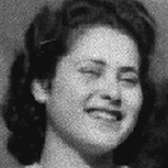
-
Learn More about Margit
Margit was born on February 26, 1922, in Innsbruck, Austria. Her father, Gottlieb Morawetz, was a banker from an observant Jewish family that originally came from the region of Bohemia (today in the Czech Republic). Margit’s mother, Lilly, was from a family of assimilated Viennese Jews. Both of her parents were well-educated, and Margit and her older brothers Felix, Paul and Bruno grew up speaking Czech, French, English and German. When Margit was an infant, her father took a job in Prague, and the family moved to the busy metropolis.
Margit’s father died of an embolism in 1932, and from the age of ten, Margit was raised by her mother with the help of a governess. By 1934 Margit and her friends began to notice a troubling rise in antisemitism in western and central Europe, including the advent of Nazi Germany. In March 1938, Nazi Germany annexed neighboring Austria, and violence against Jews was on the rise. Margit’s mother decided that it would be safer for Margit to leave Prague, so she was sent to secondary school in Paris, France where she studied dressmaking. A year later, Margit’s mother joined her. It was not long, however, before the threat that they had fled from in Prague had caught up with them.
In May 1940, Nazi Germany invaded France. Margit’s mother received an order from the French police, ordering her to report to an assembly point in the south. Margit was determined to get both herself and her mother out of France. With no other way to leave the city, Margit bought a bicycle and joined the throngs of people fleeing Paris as the German military approached. Margit rode almost 20 miles to a school in the town of Etampes, where other refugees were congregating. There, she learned that her mother had been sent to Camp de Gurs, a detention facility near the Spanish border. Margit climbed back on her bicycle and set off to find her mother. Her timing was lucky; shortly after Margit left the school, the building was blown up by German forces. Eventually, Margit was able to get a train ticket south to Salies-de-Bearn, a town near Gurs where some friends were staying.
In June 1940, France surrendered to Germany. In the confusion that ensued over the following weeks, Margit’s mother was able to leave Gurs and join Margit in Salies-de-Bearn. Together, they traveled to Marseilles. From Marseilles, they fled, via Spain and Portugal, to the United States, and settled with Margit’s brother, Felix, in New York. After America's entry into World War II in December 1941, Margit worked for the Office of War Information, making use of her knowledge of languages, which now included Spanish and Portuguese.
Margit and her first husband Otmar Gyorgy traveled extensively, living in the United States, Europe, and the Middle East. Throughout these years, Margit worked several jobs, including a stint as a German Youth Activities specialist for the US Army in occupied Germany, reeducating former members of the Hitler Youth. Margit and Otmar eventually divorced, and in 1953, Margit married Frank Meissner. The two settled in Bethesda, Maryland, and had a son named Paul, and a daughter, Anne. Frank died of cancer in 1990. Margit lived in Bethesda with her husband John Garms and volunteered at the United States Holocaust Memorial Museum. Her memoir, Margit’s Story, was published in 2003.










